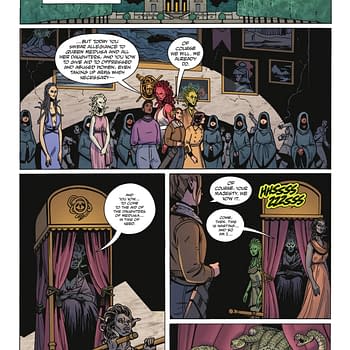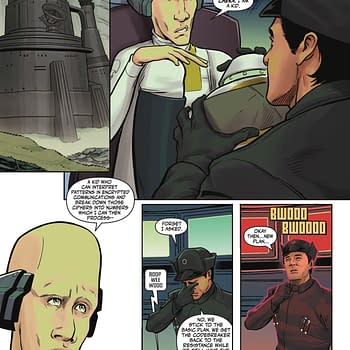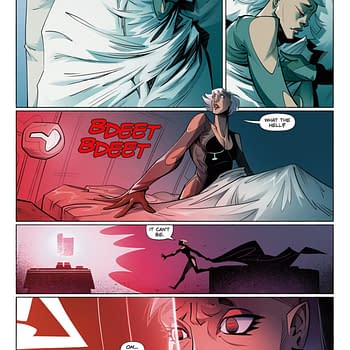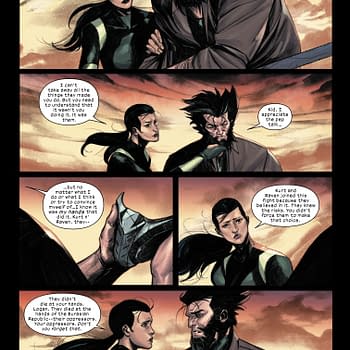Posted in: Comics | Tagged: Batman Vs. Superman: Dawn of Justice, Comics, entertainment, film, gal gadot, justice league, justice league dark, sensation comics, William Marston, wonder woman
Which Wonder Woman Will We See In Batman Vs. Superman: Dawn of Justice? The Comics Choices
By Hilton Collins
It was the costume reveal seen 'round the world—literally. On Saturday morning, July 26, at San Diego Comic-Con, Warner Bros. revealed the first official photo of actress Gal Gadot in the gear she'll be sporting as Wonder Woman in the studio's highly anticipated 2016 film, Batman vs. Superman: Dawn of Justice. The Twitter-verse exploded for a day or two (as did the entertainment media), and tongues wagged physically and digitally about the Amazing Amazon's cinematic unveiling.
Gadot stood holding a short sword in the image, staring upward with a steely gaze. Her costume resembled metallic battle armor stylized in her classic comic book look, with an eagle-shaped chest plate, and the "WW" symbol adorned a large protective belt above her battle skirt. She wore long, bullet-deflecting bracers on her arms; had her famous lasso at her side; and her boots reached above her knees. The costume's muted, brownish tones were a stark departure from the bright red, white, and blue hues the character's usually fought crime in during her 70+ years in comics and television.
Gadot looked fabulous, but her Wonder Woman outfit's darker color tone and battle-ready style screamed "warrior" and little else, leaving the world to wonder (no pun intended) whether this new live-action Wonder Woman's personality would have the same philosophical depth that's been a major part of the character's history since her inception more than half a century ago.
The character's originator William Marston created Wonder Woman in the 1940s to represent multiple things, including compassion and love for humanity—and even for her enemies—and that aspect of the character has largely remained in tact in her canonical comic book appearances, but over the past several years, DC Comics has given more and more prominence to Wonder Woman's warrior side, with confusing results. It's reached the point where Wonder Woman seems like a completely different person in her own comic today than she does in her Justice League appearances, highlighting dueling narratives. The "badass" Wonder Woman's received so much storyline reinforcement, often at the compassionate, even-tempered Wonder Woman's expense, that it's unclear which Wonder Woman Warner Bros. will bring to the silver screen.
Fighting Evil with Love
See, Wonder Woman ain't all about chopping off heads and stabbing demons through the heart, folks—or at least, she wasn't in the 1940s. Back then she reformed her very first recurring nemesis, the Baroness Paula Von Gunther, a mass murdering Nazi and slaver who'd tried to kill or enslave Wonder Woman and her allies multiple times. Von Gunther put the "E" in stylish, 1940s-art deco flavored EEEEE-villll in those days, but Wonder Woman's big bleeding heart converted her to the forces of good—all in one issue.
Wonder Woman caught Von Gunther trying to run over a little boy in Wonder Woman #3 (vol. 1, 1943)—See? EEEEE-villll—and imprisoned her on Paradise Island, the Amazons' home, before ensnaring her in the Lasso of Truth. The lasso compelled Von Gunther to admit that her hatred of children was really her sick way of suppressing her love for her own daughter, Gerta, whom the Nazi's had put in a concentration camp. They killed Von Gunther's rich husband and locked Gerta up to force Von Gunther to work for them and use her fortune and genius to help them take over the world. Wonder Woman rescued Gerta, returned her to Von Gunther, and earned the woman's friendship and gratitude. Von Gunther vowed subservience to Wonder Woman herself, but Wonder Woman said she'd serve something else instead…
[Wonder Woman vol. 1 #3, 1943]
… because folks, at her core, Wondy's all about the love.
Compassion for enemies is a personality trait that's shown up poignantly recently in issue #10 of the New 52 Wonder Woman title, when Wonder Woman professed her love for everyone…
[Wonder Woman vol. 4 #10, 2012]
… including the hell god Hades, who'd just tried to kill her for spurning his hand in marriage. Many other heroes, especially the "badass" heroes of today, would have beaten him senseless—or worse—but Wonder Woman tried to reason with him. And she even shot him with one of Cupid's love bullets (yes, you read that right. One of Cupid's love bullets) to make Hades start loving himself; because, you see, he wouldn't be such a mean, nasty, miserable old ruler of Hell if he had a better self-image.
[Wonder Woman Vol. 4 #10, 2012]
She's even formed an alliance with Hera, another God who'd spent the better part of a year's worth of issues trying to kill Wonder Woman too. In the New 52-verse, Zeus fathered Wonder Woman by fooling around with her mother Hippolyta behind Hera's back, so Hera had been pissed at Wonder Woman for being a living reminder of her husband's infidelity. Wonder Woman overlooked all that crap, though, and gave Hera a big hug (metaphorically speaking), and now they're buds.
[Wonder Woman Vol. 4 #15, 2012]
So, really, when you get down to it, Wondy delivers a good dose of therapy and loving along with the ass-whoopin', which is a rare and interesting combination in the lores of American comic book superherodom.
Judge, Jury, and Executioner
But you'd never know Wonder Woman was like that if you've only been reading her in the current Justice League family of books, because that Wonder Woman, she don't have NO time for kissing and hugging (unless it's with Superman, but that's another article).
Instead of working for peace and love, Wonder Woman's focused on fighting, and that appears to be all she's focused on—beating people up—right from her first Justice League appearance in issue #3.
[Justice League #3, 2011]
Whereas Wonder Woman's traditionally been open to reason and thinking first before resorting to violence, it seems like violence and brutality is often her preferred order of business.
[Justice League #30, 2014]
And compassion and rehabilitation? Who cares? The Wonder Woman with a new history in DC's New 52 relaunch has a new attitude, as she tells Superman: When she deals with her supervillain enemies, she "deals" with them—implying that she puts them down for good.
[Justice League #22, 2013]
A Long, Dark Road
Wonder Woman's evolution into more of a punisher than a healer has been gradual, but it's reached a high point in the past decade or so. Most of the time, she kills when she feels it's the only way out of a dire situation, the most famous case being when she snapped Maxwell Lord's neck in Wonder Woman (vol. 2 #219) to end the supervillain's murderous reign of terror. Lord told her, while wrapped up in her lasso, that ending his life was the only way she could prevent him from forcing an enslaved Superman to kill other superheroes, so she did. She didn't do it out of joy or bloodlust; she did it because she felt it was the last resort and the only way to save Superman and the rest of her brothers- and sisters-in-arms.

And for the most part, that was the only time you'd find Wonder Woman killing anyone—when she felt she had no choice. Even during the much-celebrated George Perez run, the last modern run of the character's book that many of her longtime fans felt interpreted her "right," Wonder Woman was compelled to kill for the greater good. It's why she beheaded a god in issue #5 of her series… she had no other option.
[Wonder Woman Vol. 2 #5, 1987]
But DC Comics appears to have chosen to make Wonder Woman angry and punishment-oriented in appearances outside of her own comic. Whereas she's typically lassoed people by the waist in most of her appearances, in 2013's Justice League Dark #22, she lassoed the Phantom Stranger by the throat.
[Justice League Dark #22, 2013]
It's a more violent interpretation of the character we've seen rise to prominence ever since her portrayal as the war general in Kingdom Come who slew the dangerous, superstrong Von Bach by plunging a sword through his back and out of his chest in issue #4.
[Kingdom Come #4, 1996]
A More Balanced Perspective
One can only wonder why we've seen different Wonder Women printed in our comic book pages, but storytelling efforts have been made to reconcile the warrior with the healer in one fully realized character, most recently in issue #2 of Sensation Comics Featuring Wonder Woman, which came out just this past August.
Wonder Woman faced a crisis of conscience. Gotham's worst criminals endangered the lives of innocent bystanders, and "collateral damage," as Poison Ivy taunted, was something the bad guys were good at. Wonder Woman was tempted to bust open a medieval can of godly whoop-ass on the whole lot of them, but she used a different strategy. She recruited Catwoman and Harley Quinn as temporary Amazons to help her subdue the criminals in a team effort.
[Sensation Comics Featuring Wonder Woman #2, 2014]
Then she used her lasso's truth power to make the bad guys face their fears and the core of their madness. By the end of issue, Oracle said, via caption, that some bad guys even reformed after the encounter with Wonder Woman. (Though, between you and me, that'll last all of two milliseconds, because a rehabilitated, kind, and gentle Two-Face won't cause Batman the drama the way a homicidal one will. But I digress… ) DC showed a woman that was both warrior and healer, who strove for a humane way to solve problems when she saw the option.
[Sensation Comics Featuring Wonder Woman #2, 2014]
The current Sensation Comics series seems to portray Wonder Woman the most accurately, at least if the "real" interpretation of the character is the way she was originally written, as a warrior with a strong compassionate streak who strives for the least painful—and most inspirational—solutions to problems when she can.
It's not the first time we've seen Wonder Woman like this in the comics, and it won't be the last, but this interpretation, along with so many others that have been published, does make one wonder which version DC Comics and Warner Bros. will choose when they finally bring her to movie theaters.
Writer and videographer Hilton Collins loves sci-fi and fantasy wherever he finds it, whether it's in comic books, movies, books, short stories, TV shows, or video games. On the video side, he studies filmmaking, motion graphics, and animation; and on the writing side, he covers what he loves for Bleeding Cool and on his own blog, Imagination Unplugged (www.imaginationunplugged.com), a website about entertainment and self-help for creative professionals. He is @HiltonCollins on Twitter.




























